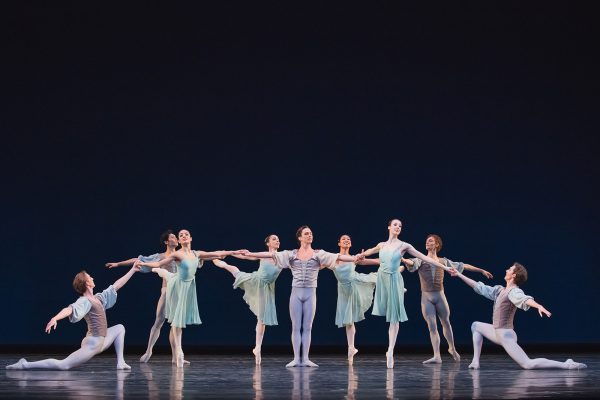Where does our love go? It’s a question that everyone ponders, especially at some of the sadder benchmarks of life – the end of a relationship, the death of a parent or friend. Dance is particularly adept at addressing the states of love and loss that define us. Veteran choreographer Michael Trent tackles it with style in loveloss.
The work is rigorous in its scenic elements. For Trent’s set design, the audience is placed around a huge square of white paper, three large funnels dripping cork dust into equidistant piles. At the edges, hanging turntables form part of a very beautiful sound design by Christopher Willes (who is seated away from the action manipulating classical music samples and other sounds into rhythmic waves). The dancers interface with the score by turning on records as they enter the performance space – scratchy vinyl recordings of Enrico Caruso, for example – which are then overlaid or drowned out by Willes’ other audio elements.
In contrast to the elegant visual and sonic landscape, the movement in loveloss feels a bit undisciplined. It’s individualized by each of the show’s five performers, the choreographer’s hand only marginally in evidence as the group coalesces and splinters, kicking at and leaping through the cork dust, settling into stillness, its morphing relationships mysterious. Snippets of the action draw attention: Ellen Furey channelling some kind of sixties French pop icon with hunched shoulders and unfocused stare; the group lying together half buried in cork dust, their shirts protecting their faces as a fan gently raises a cloud of particles; Rob Abubo spinning, gazing upward while rotating, first one way, then the other, taking a moment in between to focus his eyes and regain his balance.
The written program notes the improvisational principles behind the creation and performance of loveloss – it is part of Trent’s methodology here to allow the dancers the creative space to build a performance that organizes itself to a certain extent. I love the delicate personal calibrations that are often visible in such work. However, I just can’t help but wonder if a more powerful emotional resonance might have been achieved had Trent been as precise with his choreographic direction as he has so clearly been with his design vision.
That said, loveloss is a meditation that prompts recognition and, with it, melancholy. The final image – of the white paper floor untaped and crumpled up to contain all that cork dust within, the cast-off clothes of the dancers heaped on top – is a metaphor that everyone in the room can relate to.
A shorter version of this review appeared originally in NOW Magazine.
Tagged: Contemporary, Performance, ON , Toronto





